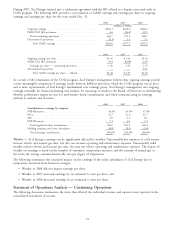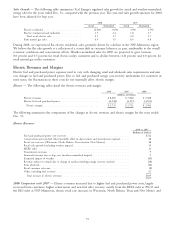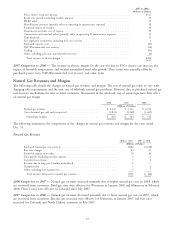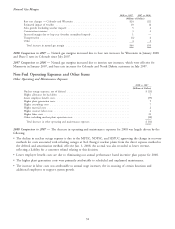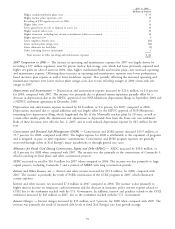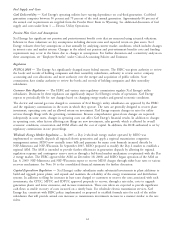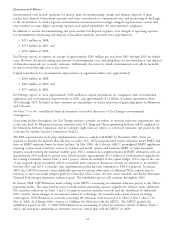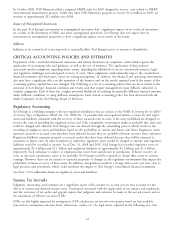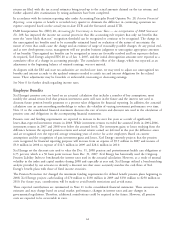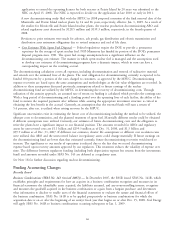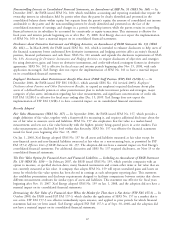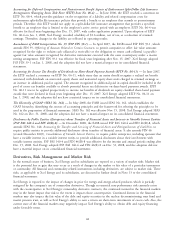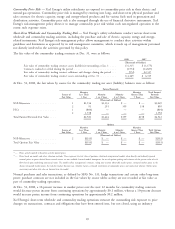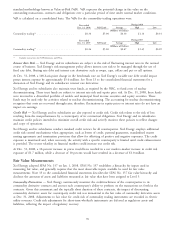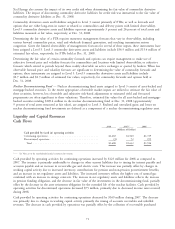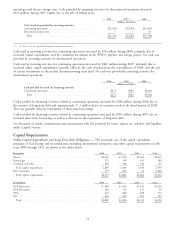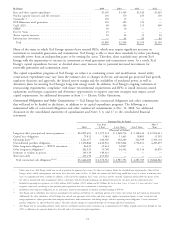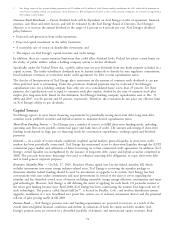Xcel Energy 2008 Annual Report Download - page 74
Download and view the complete annual report
Please find page 74 of the 2008 Xcel Energy annual report below. You can navigate through the pages in the report by either clicking on the pages listed below, or by using the keyword search tool below to find specific information within the annual report.returns are filed, with the tax accrual estimates being trued-up to the actual amounts claimed on the tax returns; and
further adjusted after examinations by taxing authorities have been completed.
In accordance with the interim reporting rules under Accounting Principles Board Opinion No. 28, Interim Financial
Reporting, a tax expense or benefit is recorded every quarter to eliminate the difference in continuing operations tax
expense computed based on the actual year-to-date ETR and the forecasted annual ETR.
FASB Interpretation No. (FIN) 48, Accounting for Uncertainty in Income Taxes — an interpretation of FASB Statement
No. 109, has impacted the income tax accrual process in that this accounting rule requires that only tax benefits that
meet the ‘‘more likely than not’’ recognition threshold can be recognized or continue to be recognized. The change in
the unrecognized tax benefits need to be reasonably estimated based on evaluation of the nature of uncertainty, the
nature of event that could cause the change and an estimate of range of reasonably possible changes. At any period end,
and as new developments occur, management will use prudent business judgment to unrecognize appropriate amounts
of tax benefits. Unrecognized tax benefits can be recognized as issues are favorably resolved and loss exposures decline.
As required, Xcel Energy adopted FIN 48 as of Jan. 1, 2007, and the initial derecognition amounts were reported as a
cumulative effect of a change in accounting principle. The cumulative effect of the change, which was reported as an
adjustment to the beginning balance of retained earnings, was not material.
As disputes with the IRS and state tax authorities are resolved over time, we may need to adjust our unrecognized tax
benefits and interest accruals to the updated estimates needed to satisfy tax and interest obligations for the related
issues. These adjustments may be favorable or unfavorable, increasing or decreasing earnings.
See Note 8 for further details regarding income taxes.
Employee Benefits
Xcel Energy’s pension costs are based on an actuarial calculation that includes a number of key assumptions, most
notably the annual return level that pension investment assets will earn in the future and the interest rate used to
discount future pension benefit payments to a present value obligation for financial reporting. In addition, the actuarial
calculation uses an asset-smoothing methodology to reduce the volatility of varying investment performance over time.
Note 11 to the consolidated financial statements discusses the rate of return and discount rate used in the calculation of
pension costs and obligations in the accompanying financial statements.
Pension costs and funding requirements are expected to increase in the next few years as a result of significantly
lower-than-expected investment returns in 2008. While investment returns exceeded the assumed levels in 2004-2006,
investment returns in 2007 and 2008 were below the assumed levels. The investment gains or losses resulting from the
difference between the expected pension returns and actual returns earned are deferred in the year the difference arises
and are recognized over the expected average remaining years of service for active employees. Based on current
assumptions and the recognition of past investment gains and losses, Xcel Energy currently projects that the pension
costs recognized for financial reporting purposes will increase from an expense of $9.9 million in 2007 and income of
$3.0 million in 2008 to expense of $12.3 million in 2009 and $28.4 million in 2010.
Xcel Energy set the discount rate used to value the Dec. 31, 2008 pension and postretirement health care obligations at
6.75 percent, which is a 50 basis point increase from Dec. 31, 2007. Xcel Energy has historically used the Citigroup
Pension Liability Index to benchmark the interest rates used in the actuarial calculation. However, as a result of unusual
volatility in the index and capital markets during 2008 and especially at year end, Xcel Energy utilized a bond-matching
analysis provided by our actuaries to identify a discount rate that more accurately matches the cash flows of Xcel
Energy’s benefit plans with those of fixed income securities.
The Pension Protection Act changed the minimum funding requirements for defined benefit pension plans beginning in
2008. Xcel Energy projects cash funding of $70 million to $130 million in 2009 and $150 million to $250 million in
2010. For future years, contributions will be made to avoid benefit restrictions and at-risk status.
These expected contributions are summarized in Note 11 to the consolidated financial statements. These amounts are
estimates and may change based on actual market performance, changes in interest rates and any changes in
governmental regulations. Therefore, additional contributions could be required in the future. However, all pension
costs are expected to be recoverable in rates.
64


